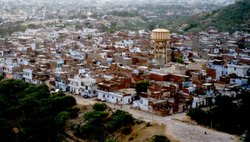Jaipur
|
|
Jaipur (जयपुर), also popularly known as the Pink City, historically sometimes rendered as Jeypore, is the capital of Rajasthan state, India. Jaipur is also the capital of Jaipur District. Jaipur is the former capital of a princely state of the same name. The city was founded in 1728 by Maharaja Jai Singh II, the ruler of Amber. The population in 2003 was approximately 2.7 million.
The city was built of pink stucco in imitation of sandstone, and is remarkable among pre-modern Indian cities for the width and regularity of its streets. The city is laid out into six quarters, separated by broad streets 111 ft. wide. The urban quarters are further divided by networks of gridded streets. Five quarters wrap around the east, south, and west sides of a central palace quarter, with a sixth quarter immediately to the east. The Palace quarter encloses a sprawling palace complex (the Hawa Mahal, or palace of winds), formal gardens, and a small lake. A fort crowns the hill in the northwest corner of the old city. Another noteworthy building is Jai Singh's observatory, Jantar Mantar.
HawaMahalJeypore.jpg
Amber_Fort,_Jaigarh_Fort_in_background.jpg
Jaipur is considered by many urbanists to be one of the best planned cities. During the British Raj, Jaipur was the capital of a princely state of the same name, ruled by the Rajput Maharajas of the Kachwaha clan. In the 19th century the city grew rapidly and became prosperous, with a population of 160,000 in 1900, and the City's wide boulevards were paved and lit with gas. Its chief industries were in metals and marble, which are fostered by a school of art, founded in 1868. There was also a wealthy and enterprising community of native bankers. The city had three colleges and several hospitals.
Jaipur state which existed from the twelfth century until Indian Independence in 1947, took its name from the city. It had a total area of 15,579 square miles in 1900. The maharajas of Jaipur belonged to the Kachwaha clan of Rajputs, claiming descent from Rama, king of Ayodhya. The state is said to have been founded about 1128 by Dhula Rai, from Gwalior, who with his Kachwahas is said to have absorbed or driven out the petty chiefs. The ruling dynasty of Jaipur provided the Mughal empire with some of their most distinguished generals. Among them were Man Singh, who fought in Orissa and Assam; Jai Singh, commonly known by his imperial title of Mirza Raja, whose name appears in all the wars of Aurangzeb in the Deccan; and Jai Singh II, or Sawai Jai Singh, the famous mathematician and astronomer, and the founder of Jaipur city. Towards the end of the 18th century the Jats of Bharatpur and the chief of Alwar each annexed a portion of the territory of Jaipur. By the end of the eighteenth century the state was in great confusion, distracted by internal broils and impoverished by the exactions of the Marathas. The disputes between the chiefs of Jaipur and Jodhpur had brought both states to the verge of ruin, and Amir Khan, an Afghan adventurer who was leader of the Pindari raiders, was exhausting the country. By a treaty in 1818 the protection of the British was extended to Jaipur and an annual tribute fixed. In 1835 there was a serious disturbance in the city, after which the British government intervened. The state later became well-governed and prosperous. During the Revolt of 1857, the maharaja assisted the British.
External links
Template:Commons- Upchaar: health (http://www.upchaar.com) The largest health website in Rajasthan.
- University of Rajasthan (http://www.uniraj.ernet.in) The largest university in Rajasthan.
- Software Technology park, Jaipur (http://www.stpj.soft.net) Promoting information technology in Rajasthan
- Jaipur Hotels (http://www.2pl.com/Jaipur/bs-4192700002.htm)
Template:India state and UT capitalsde:Jaipur fr:Jaipur hi:जयपुर nl:Jaipur pt:Jaipur sl:Džaipur sv:Jaipur

